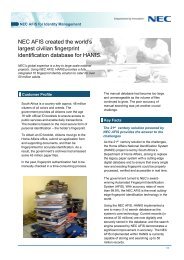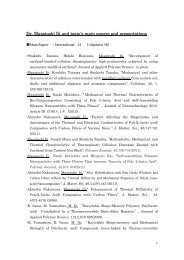Personal Identification Number (PIN) Entry Device Approved ... - Nec
Personal Identification Number (PIN) Entry Device Approved ... - Nec
Personal Identification Number (PIN) Entry Device Approved ... - Nec
Create successful ePaper yourself
Turn your PDF publications into a flip-book with our unique Google optimized e-Paper software.
General Papers<br />
<strong>Personal</strong> <strong>Identification</strong> <strong>Number</strong> (<strong>PIN</strong>) <strong>Entry</strong> <strong>Device</strong><br />
<strong>Approved</strong> by International Security Standard<br />
GOTO Masao, KIKUCHI Shigehisa, HOKOTA Hiroya, MORITA Makoto<br />
Abstract<br />
Up to the present, the credit settlement system has evolved entirely in the context of IT and it has thus established<br />
itself as a key social infrastructure. However, recent technological innovations, social structural changes and the<br />
increasing social awareness of information value and personal information security have made it necessary for the<br />
credit settlement system to utilize more advanced security technologies.<br />
NEC Infrontia has recently developed a personal identification number (<strong>PIN</strong>) entry keypad, called the “<strong>PIN</strong>pad” and<br />
has acquired the approval of the PCI (Payment Card Industry) standard, which is the international standard for <strong>PIN</strong>pad<br />
security.<br />
Keywords<br />
credit settlement, security device, PCI standard, <strong>PIN</strong>pad, <strong>PIN</strong>, PCIPED, IC card<br />
1. Introduction<br />
The number of credit cards issued in Japan has grown by<br />
25% over the last decade, and the amount of credit has increased<br />
by 86% in the same period. Under this trend of dissemination<br />
and expansion, however, abuse methods have also<br />
diversified and advanced. To deal with this issue, the Japanese<br />
credit card industry has enhanced its efforts for promoting<br />
the use of IC cards since 2003 in order to improve the<br />
security standards of credit settlements.<br />
As a result, the protection of the personal identification<br />
number (<strong>PIN</strong>) using a <strong>PIN</strong> entry keypad (<strong>PIN</strong>pad) has become<br />
a critical factor in IC card credit settlement procedures.<br />
Recently, we have succeeded in developing the high-security<br />
<strong>PIN</strong>pad and have obtained the approval of the PCI (Payment<br />
Card Industry) standard for the first time in Japan, which is the<br />
international standard for the security of <strong>PIN</strong>pad devices, as<br />
well as that of credit card companies. The product is described<br />
in detail below. *1<br />
requirements for the devices used in entering the <strong>PIN</strong> required<br />
for IC card credit settlements.<br />
Briefly the history up until the establishment of the standard<br />
is as follows. It was in 2000 that an independent standard<br />
for <strong>PIN</strong>pad devices was conceived and it was in 2004 that the<br />
international PCI standard was established. Since Japanese<br />
brands joined the standard in the fall of 2005, PCI standard<br />
approvals also became popular in Japan.<br />
The PCI SSC (PCI Security Standard Council) was organized<br />
by participation of key members from five international<br />
brands and in 2008, the <strong>PIN</strong> <strong>Entry</strong> <strong>Device</strong>s Program was defined<br />
in terms of <strong>PIN</strong>pad security requirements and was enforced<br />
as the PCI PED (<strong>PIN</strong> <strong>Entry</strong> <strong>Device</strong>s) standard.<br />
The <strong>PIN</strong>pad incorporates the latest technologies and original<br />
improvements in order to meet the requirements of the PCI<br />
standard, such as safe use against external attacks by preventing<br />
the theft of important information.<br />
3. PCI Standard Requirements Summarized<br />
2. Background to the PCI Standard<br />
The PCI standard defines the physical and logical security<br />
The security requirements for the <strong>PIN</strong>pad can be classified<br />
into the following four categories.<br />
(1)Physical Security Core Requirements<br />
Security requirements for the <strong>PIN</strong>pad hardware.<br />
*1 Since this device is security equipment, please note that some of the information cannot be opened to the public or described in details.<br />
130
(Items related to defense and detection of physical attacks)<br />
(2)Logical Security Core Requirements<br />
Security requirements for firmware.<br />
(Items related to the defense of <strong>PIN</strong> and <strong>PIN</strong> block against<br />
hacking and alterations)<br />
(3)Online Requirements<br />
Security requirements for online <strong>PIN</strong> entry.<br />
(4)Offline Requirements<br />
Security requirements for offline <strong>PIN</strong> entry.<br />
Photo 1 Model without magnetic card reader (without privacy<br />
screens).<br />
4. Merchandise Specifications<br />
Table shows the specifications of the newly developed <strong>PIN</strong>pad<br />
product.<br />
Photo 1 and Photo 2 respectively show external views of<br />
the <strong>PIN</strong>pad, for the model without the magnetic card reader and<br />
one with it.<br />
Table<br />
<strong>PIN</strong>pad specifications.<br />
Photo 2 Model with a magnetic card reader (with privacy screens).<br />
5. Technologies Applied, Features<br />
5.1 The Physical Technologies and Their Features<br />
The functions necessary to meet the physical requirements<br />
are resistance to attacks and detection of attacks received.<br />
(1)Technology for Detecting Attacks<br />
The mechanism required for detecting an attack is to install<br />
multiple switches and sensors and to erase the sensitive information<br />
(<strong>PIN</strong>, encryption key, etc.) immediately when any<br />
one of them is activated ( Fig. ).<br />
This device also has functions for detecting physical attacks<br />
such as an opening of the case, removal of a circuit<br />
board or cutting of a circuit board by various means. One of<br />
the known environmental attack techniques is the low-temperature<br />
attack on the memory. This device detects such an<br />
attack by incorporating a temperature sensor IC.<br />
(2)Technology for Resistance to Attacks<br />
In order to reduce the probability of receiving attacks, this<br />
device is designed to eliminate unnecessary clearances and<br />
spaces wherever possible ( Photo 3 , Photo 4 and Photo 5 ).<br />
NEC TECHNICAL JOURNAL Vol.3 No.3/2008 ------- 131
General Papers<br />
<strong>Personal</strong> <strong>Identification</strong> <strong>Number</strong> (<strong>PIN</strong>) <strong>Entry</strong> <strong>Device</strong> <strong>Approved</strong> by International Security<br />
Standard<br />
Photo 5 Visible card insertion slot that can show the presence of a<br />
skimming device at a glance.<br />
Fig.<br />
Attack detection method.<br />
Photo 6 Internal protection with a built-in case shielding for attack<br />
detection.<br />
Photo 3 Elimination of clearance for inserting two IC cards.<br />
ment section of the case.<br />
The main issue in the circuit design is to protect the part that<br />
saves the sensitive information (memory) so that internal<br />
sensitive information is not illegally accessed in a direct attack<br />
of the memory. This device achieves protection of the<br />
main circuitry including the memory by shielding it with a<br />
case that has a built-in attack detection circuit ( Photo 6 ).<br />
5.2 Logical Technologies and Their Features<br />
Photo 4 Elimination of space for entering a skimming device inside.<br />
This measure is taken to eliminate the possibility that an attacker<br />
may insert a skimming device between the IC card and<br />
the case if the IC card insertion slot has a clearance exceeding<br />
the thickness of a card.<br />
The device is also designed to retain evidence of an attack<br />
by using a curved line, instead of straight one, in the case<br />
engaging section. This is because a curved engagement section<br />
is difficult to open and leaves evidence of opening if an<br />
attacker attempts to open the case by cutting into the engage-<br />
The functions necessary to meet the logical requirements are<br />
1) Impossibility for the attacker to know or guess the <strong>PIN</strong><br />
2) Impossibility of overrun even when the <strong>PIN</strong>pad receives<br />
unexpected communication data (The attacker attempts<br />
to trigger unexpected operation by causing overrun.)<br />
3) Impossibility for a third party to insert a malicious program<br />
into the <strong>PIN</strong>pad<br />
4) Deletion of sensitive information when an attack is detected<br />
This device fulfils the above requirements with the technologies<br />
as described below.<br />
(1)Impossible for the Attacker to Know or Guess the <strong>PIN</strong><br />
The <strong>PIN</strong>s entered by users are not output from the <strong>PIN</strong>pad.<br />
The entered data is encrypted every time a key is pressed and<br />
it is saved as sensitive information. It is then deleted when it<br />
becomes redundant (after the <strong>PIN</strong> has been output to the IC<br />
132
card) or when the timeout is reached after start of the key<br />
entry.<br />
The above operations minimize the retention of <strong>PIN</strong>s in the<br />
<strong>PIN</strong>pad. Even when they are retained, they are encrypted to<br />
reduce the risk of <strong>PIN</strong> thefts by attacks.<br />
The key entry tone generated during <strong>PIN</strong> entry is always<br />
identical and the display shows meaningless characters (asterisks)<br />
in order to prevent the <strong>PIN</strong> from being guessed from<br />
the key entry tone or display.<br />
(2)Impossibility of Overrun Even When the <strong>PIN</strong>pad Receives<br />
Unexpected Communication Data<br />
A special defense program that can deal with data other than<br />
the command data specified in accordance with the specifications<br />
in the form of completely meaningless data is incorporated<br />
in order to prevent attacks that attempt to cause<br />
program overrun by sending a large amount of data or unexpected<br />
data.<br />
(3)Impossibility for a Third Party to Insert a Malicious<br />
Program in the <strong>PIN</strong>pad<br />
Each <strong>PIN</strong>pad is given a unique encryption key for use in<br />
firmware rewriting, and a hash value is assigned to the firmware<br />
information to prevent it from being altered by a third<br />
party.<br />
(4)Deletion of Sensitive Information When an Attack is<br />
Detected<br />
Sensitive information is deleted when an attack is detected.<br />
Any data containing sensitive information is cleared immediately<br />
after use and not left in the memory. Data containing<br />
sensitive information is not used in an external memory<br />
that is not protected by a shield case with built-in attack detection<br />
circuitry.<br />
In addition, sensitive information is checked periodically. If<br />
it is found that the information has changed, an attack is<br />
identified and the information is deleted immediately.<br />
6. Conclusion<br />
In the above paper, we discussed the device development of<br />
the <strong>PIN</strong>pad approved by the PCI standard for the first time in<br />
Japan.<br />
As the PCI approval of the device has led to market evaluation<br />
of its superiority, we have already shipped about 50,000<br />
units for use in POS-connected IC card credit settlement systems<br />
of major mass-sales stores as well as for OEM supply to<br />
major manufacturers.<br />
Against a background of progress in technological innovation,<br />
the techniques of attachment are also advancing each year<br />
and the required security levels are changing. Accordingly, the<br />
PCI standard was upgraded from Version 1.3A to 2.0 on April<br />
1, 2008 and it now incorporates the achievement of more advanced<br />
security levels as product requirements.<br />
Based on the expertise that we have acquired in the development<br />
of the present device, we will endeavor to further<br />
improve our technology so that it will be able to clear even<br />
higher security standards and will help in continuing to expand<br />
our market presence.<br />
References<br />
1) Statistics of Japan Consumer Credit Industry Association<br />
2) “Payment Card Industry (PCI) <strong>PIN</strong> <strong>Entry</strong> <strong>Device</strong> (PED) Testing and Approval<br />
Program Guide,” Version 1.0, December 2007<br />
3) PCI POS PED Security Requirements v1.3<br />
4) PCI POS PED DTRs v1.3<br />
5) EMV Integrated Circuit Card Specifications for Payment Systems<br />
(c)1994-2004 EMV Co, LLC (“EMV Co”). All rights reserved.<br />
6) ANS X9.24-2004 Retail Financial Services Symmetric Key Management<br />
(c)2004 Accredited Standards Committee X9, Inc. All rights reserved.<br />
Authors' Profiles<br />
GOTO Masao<br />
Expert,<br />
3rd Product Development Group,<br />
i Appliances Division,<br />
NEC Infrontia Corporation<br />
KIKUCHI Shigehisa<br />
Manager,<br />
3rd Product Development Group,<br />
i Appliances Division,<br />
NEC Infrontia Corporation<br />
HOKOTA Hiroya<br />
3rd Product Development Group,<br />
i Appliances Division,<br />
NEC Infrontia Corporation<br />
MORITA Makoto<br />
3rd Product Development Group,<br />
i Appliances Division,<br />
NEC Infrontia Corporation<br />
NEC TECHNICAL JOURNAL Vol.3 No.3/2008 ------- 133
















